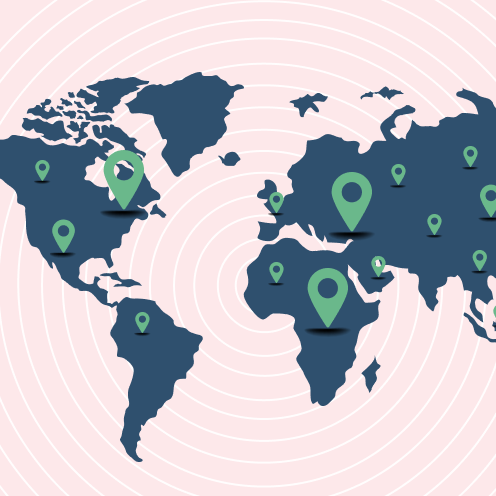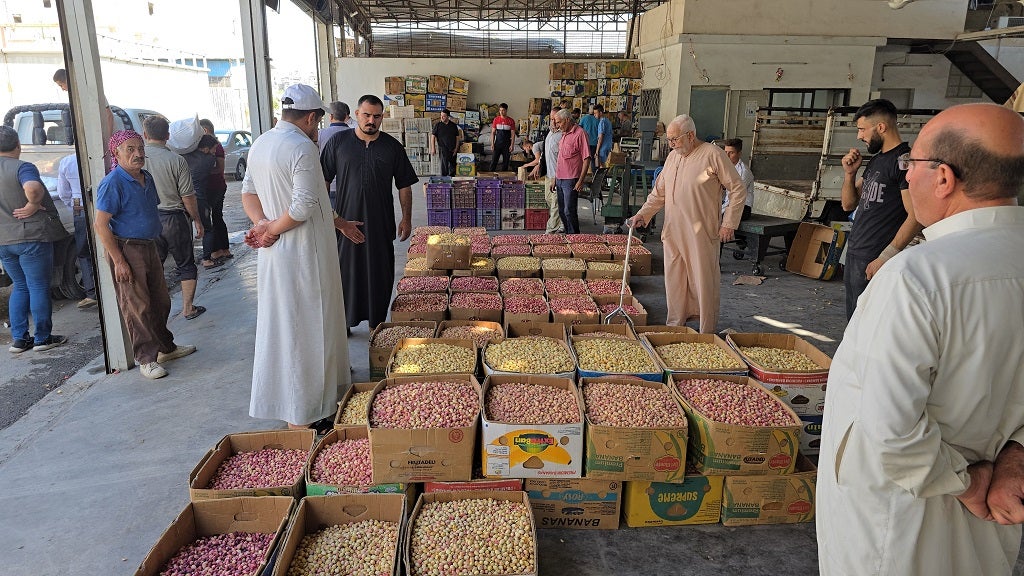- News
- World
- Middle East
Pistachio farmers in northern Syria are facing one of their toughest seasons yet, as drought, pests and rising costs threaten a crop long considered the country’s “red gold”, Mustafa Rostom reports
Sunday 23 November 2025 09:26 GMTComments
 CloseSyria's "red gold" pistachio trees suffering from drought
CloseSyria's "red gold" pistachio trees suffering from drought
On The Ground newsletter: Get a weekly dispatch from our international correspondents
Get a weekly dispatch from our international correspondents
Get a weekly international news dispatch
 Email*SIGN UP
Email*SIGN UPI would like to be emailed about offers, events and updates from The Independent. Read our Privacy notice
This article first appeared on our partner site, Independent Arabia
Imad Sarmani, a farmer from the town of Khan Sheikhoun in Syria’s southern Idlib governorate, known by his nickname Abu Abdo, sits on the balcony of his house sipping coffee and overlooking a farm adorned with greenery, from which clusters of pistachio trees hang.
He feels a quiet satisfaction with the effort he has made throughout a year of ploughing, watering the trees and fighting the insect pests that have spread through the area in recent years.
He is racing against time to prepare for the harvest season, known locally as al hawash, when he will reap the fruit of his farm. He has already prepared the necessary tools and hired workers. Before that, he deployed guards to patrol the land and keep out intruders or thieves. It is an unsurprising measure given these trees heave “red gold” on their branches.
Recommended Cautious calm in Aleppo after clashes between Syrian forces and Kurdish fighters
Cautious calm in Aleppo after clashes between Syrian forces and Kurdish fighters French court to decide if Assad can be stripped of immunity and tried for Syrian chemical attacks
French court to decide if Assad can be stripped of immunity and tried for Syrian chemical attacks 1,500-year-old Byzantine tomb complex discovered under Syrian war ruins
1,500-year-old Byzantine tomb complex discovered under Syrian war ruins
The farmer, who is in his sixties, was adamant that he never abandoned his land, not even during the worst days of the decade-long civil war in Syria.
Speaking to Independent Arabia, he says: “I have never abandoned my land, and I never will.” He speaks with the resolve of a person whose roots are deeply embedded in the earth, much like the ancient poplar, pistachio and walnut trees that surround him.
.jpg) open image in galleryDrought has severely affected Aleppo’s prized “red gold” crop of pistachios (Independent Arabia)
open image in galleryDrought has severely affected Aleppo’s prized “red gold” crop of pistachios (Independent Arabia)“I travelled abroad when the war intensified, but I quickly returned. I will never abandon my homeland,” he said. While his children have left to study and work elsewhere in the Middle East and Germany, Abu Abdo remains on his farm, cultivating what he calls a “treasure”.
Things are different this year, however, with drought severely affecting the crop.
Abu Abdo gives us a tour of his sprawling farm. He has faced a lot of difficulties due to its proximity to areas controlled by the former regime, which meant constant encounters with unruly shabiha militias. The checkpoints scattered across the area, especially those operated by the 4th Armoured Division, engaged in widespread theft, looting and extortion against farmers.
However, the situation changed after the fall of the Assad regime on 8 December 2024. Cars can now move freely to transport produce to the large markets of Damascus, Aleppo and other Syrian cities.
The killer bug
At the Aleppo pistachio market, supervisor Abdul Basit Dalil tells Independent Arabia about an unprecedented drop in sales and purchases compared to previous years. Prices vary depending on the type of pistachio, but all kinds currently sell for around $6 (£4.50) per kilo.
Farmers and traders are eager to export to foreign markets, where they can get between $20 and $30 (£15-£20) for a kilo of pistachios.
When we arrived at the pistachio market, one grower and trader we met told us, “We suffered from the drought that hit Syria, and the pistachio trees were greatly affected. People started looking for solutions.”
He said that those who had the means to dig wells were able to water their crops, and explained: “The spread of diseases caused by Capnodis tenebrionis beetles and mealybug infestation has reduced production by 20 to 30 per cent compared with previous years.
“Despite this, the quantities available are sufficient for the local market. However, Syria also exports Aleppo pistachios, and we hope that marketing, customs and sales will be facilitated.”
 open image in galleryFarmers and traders at the Aleppo pistachio market share their concerns about declining yields and rising costs (Independent Arabia)
open image in galleryFarmers and traders at the Aleppo pistachio market share their concerns about declining yields and rising costs (Independent Arabia)The capnodis beetle emerges between April and August. In winter, it hibernates in dense vegetation or under fallen leaves, and lays an average of 30 eggs at the base of the tree stem or in cracks along the branches. After two months, the eggs hatch and larvae emerge to burrow into the trunk and roots of the pistachio trees.
Mohammed Saeed, a farmer from the town of Suran in the Hama countryside, explains how the drought has affected his town: “The pistachio trees were affected by this problem to the point that they withered, and insects such as the capnodis beetle spread while farmers were away from their land under the former regime.”
For his part, Muhammad Kishto, Head of the Federation of Syrian Chambers of Agriculture, offered reassurances based on his own estimates of increased production, particularly as harvesting continued until mid-September. He confirmed to Independent Arabia that the drought had affected crops in Syria, including Aleppo pistachios. However, he explained that pistachios follow an alternate bearing cycle, whereby they produce a heavy crop one year then a light or no crop the following year, before returning to normal production in subsequent seasons.
“Production is expected to increase by 50 to 55 per cent,” he says. “It is an important crop for the economy as it is both exported and used in the confectionery industry. It is mainly grown in the northern and southern rural areas of Hama and Idlib, as well as in the Aleppo countryside, with smaller areas in Homs and Suwayda. Climate conditions determine where it can be cultivated.”
Even so, farmers and traders are looking to export Aleppo pistachios in order to offset losses from declining yields and the high costs of fertilisers, electricity and fuel oil. There are also fears that production will fall again next year due to continuing drought.
Holding a tree branch, Abu Abdo says: “These are pistachio trees, but they won't bear fruit next year because the drought caused the fruit to fall off. Normally, between 5 and 10 per cent of the fruit would remain on the trees, but they've all wilted, so we can expect a poor harvest next year.”
The story of pistachios
The pistachio tree is one of the most important in the Mediterranean basin, with origins stretching back thousands of years. It was grown across the Mediterranean region, which is known for fertile soil and a diverse climate that make it ideal for agriculture.
Historical sources indicate that the pistachio originated in northern Syria, particularly in the northern and central governorates of Aleppo, Hama and Idlib. The Aleppo pistachio has held a special place in ancient cultures and civilisations throughout history.
The earliest evidence of the use of Aleppo pistachios dates back to the Bronze Age in the Mediterranean basin, specifically in Aleppo. Pistachios were introduced to Europe in the first century AD by the Romans who brought them over from Syria.
The so-called “red gold” tree has long been an economic lifeline, generating profits that boost national income and sustain rural communities through exports and foreign currency earnings.
Aleppo pistachios are also widely used in the food industry, particularly in sweets and other culinary products, elevating dishes with their distinctive flavour. Beyond their gastronomical use, Aleppo pistachios have long been valued for their health benefits and used in traditional medicine.
Translated by Mirane Abouzaki; Reviewed by Tooba Khokhar and Celine Assaf
More about
Syriaclimate changeAgricultureJoin our commenting forum
Join thought-provoking conversations, follow other Independent readers and see their replies
Comments.jpg?width=1200&auto=webp&trim=0%2C0%2C0%2C160)



